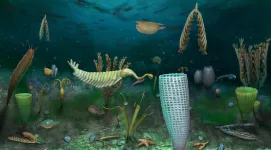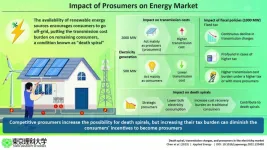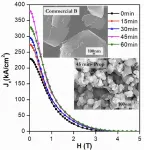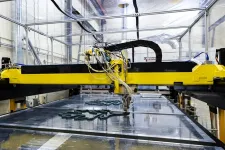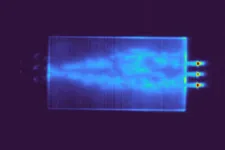More than a decade after the theory of interdependent networks was introduced, researchers establish the first physics laboratory benchmark for its manifestation
New findings enable experimental studies to control and further develop the multiscale phenomena of complex interdependent materials
2023-05-01
(Press-News.org)
In 2010 Prof. Shlomo Havlin and collaborators published an article in the journal Nature proposing that the abrupt electricity failure causing the famous 2003 Italy blackout was a consequence of the inter-dependency of two networks. According to Havlin's theory the dependency between the power network and its communication system led to cascading failures and abrupt collapse. Havlin's seminal work ignited a new field in statistical physics known as “network of networks” or "interdependent networks" and paved the way for understanding and predicting the effects of the interaction between networks.
The main novelty of Havlin's model is the existence of two types of links which represent two qualitatively different kinds of interactions. Within networks, links between nodes describe connectivity such as electric power or communication connections. Between networks, on the other hand, links describe dependency relationships in which the functionality of a node in one network depends on the functionality of a node in the other. The communication hubs need electricity and the electric power stations depend on communication control. This dependency leads to a cascading effect in which failure of a single node in one of the networks could lead to an abrupt breakdown of both networks.
Over the past decade or so since, Havlin, from the Department of Physics at Bar-Ilan University in Israel, and others have applied this concept to a variety of abstract systems, such as the internet, road traffic, the economy, infrastructure, and more. But being a theorist, Havlin was unable to manifest the hypothesis on real experimental physical systems and thus the theory couldn't be confirmed in controlled experiments, nor could it be implemented for device-type applications.
Recently, Havlin joined forces with his colleague, Prof. Aviad Frydman, an experimentalist in the Physics department at Bar-Ilan who specializes in electrical properties of disordered systems, in particular superconductors. Superconductivity is a phenomenon observed in certain metals where electric resistance vanishes when the system is cooled down below a critical temperature.
Inspired by Havlin’s theory, Frydman’s group developed a controlled system of interdependent superconducting networks, a physical analogy to the interdependent networks involved in the Italy blackout. The two superconducting networks are separated by a layer which is an electric insulator but enables transfer of heat between the networks, thus creating a system of two types of interactions. Within each layer, the electric currents represent connectivity links while the heat flowing between networks represents dependency links since it can disrupt the superconductivity segments.
Havlin's and Frydman’s collaborative groups included lab manager Dr. Ira Volotsenko and three graduate students, Dr. Ivan Bonamassa, Bnaya Gross and Maayan Laav.
The research conducted by the two groups, published today in the journal Nature Physics, shows that while separate, uncoupled networks exhibit a smooth, continuous transition between a superconductor and a normal metal as temperature is increased, coupled systems show an abrupt, discontinuous transition, as predicted by the theory. This is attributed to the fact that the current flowing in a normal segment of one layer causes a superposed segment in the other layer to become hotter, and hence, lose its superconductivity. This thermal feedback process between the layers continues in a self-propagating fashion (i.e., cascading back and forth between the layers) and eventually results in a spontaneous propagating avalanche of junctions entering the metallic phase.
The breakthrough study establishes the first physics laboratory benchmark for the manifestation of the theory of interdependent networks, enabling experimental studies to control and to further develop the multiscale phenomena of complex interdependent materials.
This research has vast significance in several disciplines, including basic physics, materials science and device applications. In basic physics, the scientific impact is in the discovery of new physics phenomena related to phase transitions. The results demonstrate that phase transitions governed by a single interaction type, extensively studied for over 100 years, are just a limiting case of a much richer, general phenomena governed by several types of interactions. The results may also lead to the establishment of a new field of network metamaterials based on coupled layers with different inter-layer interactions exhibiting novel physics phenomena. The research also indicates that the abrupt breakdown of a network system may be a desirable phenomenon. If harnessed, it can be applied toward engineering self-healing systems or to devise high-sensitive switchers or sensors, for example, for single-photon detection.
While network science originated from physics in 2000, its subsequent development and applications have surprisingly not benefitted physics, but almost all other scientific and technological fields. The present study reconnects network science and physics. It is the first to demonstrate that novel concepts developed by network science can significantly benefit physics while discovering novel physical processes, such as new types of phase transitions, when studying interdependent physical systems.
END
[Attachments] See images for this press release:

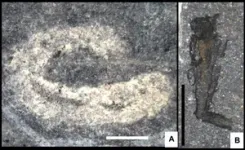
ELSE PRESS RELEASES FROM THIS DATE:
2023-05-01
An unusually well-preserved "Marine Dwarf World" from 462 million years ago was found at Castle Bank, Wales by a team led by the Nanjing Institute of Geology and Palaeontology of the Chinese Academy of Sciences (NIGPAS). The site comprises over 150 species, with many of miniaturized body size. It is one of the world's most unexpected fossil sites.
The study was published in Nature Ecology & Evolution on May 1.
Castle Bank, in Powys, is one of the very rare sites where soft tissue and complete organisms are preserved, providing ...
2023-05-01
TAMPA, Fla. (May 1, 2023) – Ten Florida inventors inducted into the Florida Inventors Hall of Fame demonstrate that a personal drive to improve the human condition is a powerful force for transformation. Among them are Jonathan Rothberg, who pioneered the next-generation of human DNA sequencing, enabling low-cost decoding of human and other living organisms’ genomes; and Daniel Joseph, whose advances in special effects and illusion at Disney Imagineering have revolutionized the theme park experience ...
2023-05-01
Efforts to combat climate change have contributed to the rise of renewable energy production through solar panels, windmills, and other technologies. Because of this, consumers have now become “prosumers,” capable of producing their own electricity. While the prosumers’ use of distributed renewable energy increases the energy sector’s resilience, their decreased reliance on the bulk electricity market has led to new and unintended consequences.
It is anticipated that these avenues will push traditional consumers to become prosumers, making it difficult to recover lumpsum infrastructure investments ...
2023-05-01
Magnesium diboride (MgB2), a binary compound, behaves as a superconductor – a substance that offers no resistance to electric current flowing through it – at a moderate temperature of around 39 K (-234°C). This temperature can be achieved using relatively inexpensive liquid hydrogen or neon coolants. In addition, MgB2 is inexpensive, lightweight, and non-toxic, and its precursors – magnesium (Mg) and boron (B) – are abundantly available. As a result, it can replace conventional low-temperature ...
2023-05-01
Boston, MA - Hebrew SeniorLife, a Harvard Medical School-affiliated, integrated system of health care, senior living, research, and teaching that serves more than 3,000 Greater Boston seniors each day, announces the appointment of Steve Landers M.D., MPH as its new president & chief executive officer.
Dr. Landers comes to Hebrew SeniorLife from Visiting Nurse Association (VNA) Health Group, Inc., one of the oldest, largest, and most respected home health, hospice, and community health organizations in the country, where he has served since 2012 as president and chief executive officer. He is a practicing physician, certified in family medicine, geriatric medicine, and ...
2023-05-01
At the end of 2022, the federal government eliminated the “X waiver,” a major hurdle to providing addiction treatment, but progress needs to be continued, according to the authors of a new Perspective piece published in the New England Journal of Medicine. The X waiver required a special license and uncompensated training for physicians and other prescribers, creating a regulatory barrier to offering lifesaving buprenorphine treatment for opioid use disorder. Ending the X, the authors write, is necessary but not sufficient to achieve overdose-prevention goals.
Sarah Wakeman, MD, Medical Director for Substance Use Disorder at Mass General Brigham, and her co-author ...
2023-05-01
CHAMPAIGN, Ill. — The mechanics behind the collapse of soft materials structure have befuddled researchers for decades. In a new study, researchers uncover a metric that finally correlates microscopic-level processes with what is seen at the macroscopic level.
The new metric is poised to help bring advances to various materials engineering challenges – ranging from the formulation of better 3D printing inks, the construction of wearable flexible electronics and sensors, the accurate printing of biomedical implants, to helping control landslides and avalanches, and ...
2023-05-01
(Boston)–Five Boston University Chobanian & Avedisian School of Medicine faculty have been honored as 2023 Educators of the Year by the School’s Awards Committee. Nominated by students and faculty, the annual awards recognize School of Medicine educators who provide excellence in teaching and mentoring.
This year’s recipients are Ricardo Cruz, MD, MPH, Educator of the Year, Preclerkship; Julia Bartolomeo, MD, Educator of the Year, Clerkship; Lillian Sosa, MS, CGC, Educator of the Year in MA/MS Programs; Douglas Rosene, PhD, ...
2023-05-01
(Boston)—Sean D. Tallman, PhD, RPA, assistant professor of anatomy & neurobiology at Boston University Chobanian & Avedisian School of Medicine, has been awarded a Fulbright Scholar Award. This award allows U.S. academics to engage in multi-country, trans-regional projects.
Tallman will travel to South Africa for 10 months to conduct human skeletal biology research for his project, "Assessing the Effects of Disadvantage and Ancestry in Skeletal Health and Forensic Medicine" at the University of Cape Town and Stellenbosch University.
Tallman ...
2023-05-01
Photonic chips have revolutionized data-heavy technologies. On their own or in concert with traditional electronic circuits, these laser-powered devices send and process information at the speed of light, making them a promising solution for artificial intelligence’s data-hungry applications.
In addition to their incomparable speed, photonic circuits use significantly less energy than electronic ones. Electrons move relatively slowly through hardware, colliding with other particles and generating heat, while photons flow without losing energy, ...
LAST 30 PRESS RELEASES:
[Press-News.org] More than a decade after the theory of interdependent networks was introduced, researchers establish the first physics laboratory benchmark for its manifestation
New findings enable experimental studies to control and further develop the multiscale phenomena of complex interdependent materials


